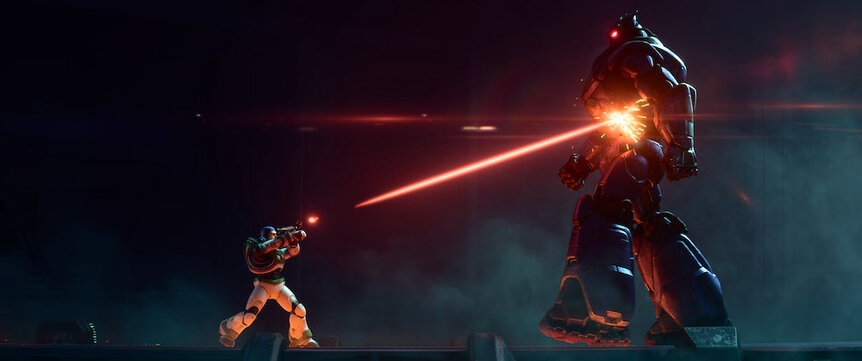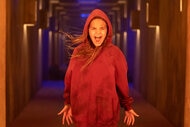Create a free profile to get unlimited access to exclusive videos, sweepstakes, and more!
'Lightyear' director on Chris Evans' infamous tweet and where it fits in 'Toy Story' canon
The director and producer explain where the idea came from and why it's not exactly the IP spin-off you might think it is.

Shortly after the announcement of Lightyear, Pixar’s new movie about the Space Ranger from the Toy Story franchise, star Chris Evans took to Twitter in an attempt to clarify something.
“And just to be clear, this isn’t Buzz Lightyear the toy,” he tweeted in December 2020. “This is the origin story of the human Buzz Lightyear that the toy is based on.”
The tweet, while charming, was widely mocked and, it turns out, not accurate nor especially helpful in clarifying what the movie was.
“When we had the next recording session, he was like ‘Yeah, I think I kind of messed that up.’ We were like, ‘It’s fine,’” director Angus MacLane tells SYFY WIRE. “It’s not a messaging problem. Even with the clearest messaging, [the premise of the movie] still completely keeps breaking the internet and minds everywhere who are wondering what exactly this is.”
Lightyear, which hits theaters on June 17, begins with an opening crawl that MacLane hopes clarifies things for the audience once and for all. In 1995, a boy named Andy got a toy inspired by his favorite movie. Lightyear is that movie. Simple.
Even so, SYFY WIRE still had some questions, and MacLane and producer Galyn Susman spoke with us about the film’s fictional history, the emotional resonance of the story, and where Lightyear fits into Hollywood’s current IP obsession.
Lightyear is interesting in this media landscape that’s all about preexisting IP. Because, on the one hand, it’s a spin-off of Pixar’s first and arguably most famous movie. But, on the other hand, all that Toy Story really tells us about Buzz Lightyear is his name, his appearance, and that he’s a space ranger. So in a way you have the freedom to just be an original sci-fi story. Can you talk about that paradox a little bit? Were you aware of this interesting contrast, and how did you approach making the film with this in mind?
Angus MacLane: That’s a very astute observation. I think that’s what drew us to the potential. It has a recognizable IP with tons of creative freedom because there’s so little pinned down. We wanted to make a sci-fi action film and we always loved Buzz Lightyear having worked with him. It allowed the creative freedom and the space, because of the way we were framing it, to really pursue the movie without having to do a checklist of things we were expected to hit for “the Buzz Lightyear movie,” if that makes sense.
You need to have Zerg, he’s got to say “to infinity, and beyond,” he’s got to have an arm laser, he should have wings. Those are the few things [you have to do], but I think it’s really telling that the character that people are most excited about is Sox, who is not a canon character in the Buzz Lightyear universe. People aren’t aware of him. The way I think about movies is that you want to give the audience something they don’t know they want. You want to give them something that they’re familiar with, but you also want to give them something that they’re not familiar with. And, it’s that balance that this film hopes to bridge.
Did the “Pixar space movie” idea come first or did the “explore Buzz” idea come first?
MacLane: It was always the same. I didn’t think about a space movie without him. Imagine you’re working at Pixar. They’re a well-received emotional powerhouse [that makes] tear-jerking classics. And you’re like “alright, how are we going to make the audience cry?” Say you start with that, cynically — and I’m not saying that’s how we start — but say you’re starting with “how are you going to make the audience cry?”
Eventually, I’m like “I don’t care! I just wanna make a space movie! Make something awesome! What about Buzz Lightyear? Yeah, let’s get Buzz in here. That will be awesome!” Literally, that was the thing. “Why are we spending our time trying to make ourselves cry and why don’t we instead make something that will be totally awesome?”
So that became our rallying cry for what we wanted out of the end product. Is it awesome? Okay, good. It’s a weird way to think about it, but because we’d been so connected to Toy Story, but there isn’t a lot of mythology to it, if you look just at the feature films. I’m not including the cartoon show.
The big theme of this movie seemed to be about failure — and perhaps more importantly, being able to look past perceived failures and see things for what they are. Can you talk about how that emerged?
MacLane: It was a win-win, because if we didn’t succeed with the movie, then we would have a well to draw on. [Laughs.]
Galyn Susman: That’s so dark. When you’re working on a movie for five and a half years, there have to be personal connections. I think a lot of the things [in the movie] are things that we’re talking about and thinking about where we are in life. “Are we valuing what we have in front of us right now? Are we too nostalgic? Are we focusing too much on the past? Are we too focused on an arbitrary goal in the future? Are we being too self-absorbed? Are we valuing the people that we have around us?” These are the kinds of things that are bothering us right now. If you’re ruminating on something for five and a half years, you might as well make it align with what you’re talking about in real life.
I was looking at the types of sci-fi movies that were coming out in 1995 and, well, let’s just say that Lightyear is a much more emotionally mature film than most of the films in the genre of the era. Was there ever a desire to really lean into the strange, metatextual period piece opportunity, or was it always going to be a movie for 2022?
MacLane: I would say the latter, but I always envisioned that it was made in 1986, and it was in 1995 that Andy got the toy after having seen the film a lot on VHS and there being an offshoot TV cartoon. Because a lot of times sci-fi movies didn’t have a merchandising partner at the time. So, for example, there were no Rambo toys for First Blood or First Blood Part II, but there were for the Rambo TV cartoon. When Andy found out they were going to make a Lightyear cartoon he was stoked, and that’s where he got the toy, from that. That’s what the stylistic difference is.
That makes more sense than Lightyear being a 1995 movie and competing against Species.
MacLane: It’s just a different thing. There’s Stallone in First Blood, and there’s the Rambo cartoon. There’s Peter Weller in Robocop and there’s Robocop and the Ultra Police. It’s just different. They exist in different universes.
Lightyear isn’t exactly an origin story, though there are shades of it. Can you talk about why you wanted to tell this story at this point in Buzz’s arc?
MacLane: Raiders is a bit like that. It’s not the origin of Indiana Jones. It’s meant to be an adventure with the character, an established character and you’re catching an adventure in a larger narrative. I think that, becoming something can be interesting, or it can be boring. Like, if you know he’s going to be a Space Ranger, you’re just like “get to it.” That can be really frustrating to the audience. I was attracted to narratives where we didn’t know everything. There are things that happen before, there are things that happen after, this is just one moment. How much do you need to know? We’re not going to get into all of the minutiae. We’re not going to go to the academy. It is an in-between adventure.
One that happens to span generations even though it takes place over the course of about a week.
MacLane: Yeah, it’s a quick movie. Most thriller movies take place over three days. So it’s not quite like that, but to the audience, it’s a very quick adventure.
Lightyear opens in theaters on June 17.
Looking for more space adventures? Stream SYFY's Resident Alien right here on Peacock.




























